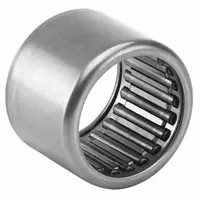Shell Type Needle Roller Bearings
Shell type needle roller bearings are light-weight bearings with large load ratings. They employ a shell type outer ring made from a thin special-steel plate which is accurately drawn, carburized and quenched, thus providing the lowest sectional height among the needle roller bearings.
There are two types of bearings available in this series; the caged type and the full complement type. The appropriate type can be selected according to the operating conditions.
The Caged Type has a structure in which the needle rollers are accurately guided by the cage and thrust rings. It is useful for applications at high-speed rotation.
The Full Complement type needle roller bearing, on the other hand is suitable for heavy-load applications at low speed rotation.
Since these bearings are press-fitted into the housing, no fixtures for axial-positioning are needed. They are ideal for use in mass-produced articles that require economy and have a wide variety of applications.

Needle roller bearings handle relatively high loads in a compact design envelope. This technical advantage has made the needle roller bearing the preferred choice of bearing in a wide variety of industrial and automotive power transmission applications over the years.
A needle roller bearing is a bearing that uses small cylindrical rollers. These rollers are used to reduce friction of a rotating surface. Compared to ball bearings, needle roller bearings have a large surface area that is in contact with the bearing raceway journals.
The typical structure of a needle roller bearing comprises an inner race (or sometimes just a shaft), a needle cage which orients and contains the needle rollers, the needle rollers themselves, and an outer raceway. There are many different designs of needle roller bearing, including drawn cup, precision race, caged roller, and thrust roller.
Hide details
Cage Type Needle Roller Bearings
Cages, whether steel or plastic, can be made in a variety of different constructions, including solid cage, single split and split halves (two-piece). These cages can also incorporate lubrication passages and other custom designed features.
Typical applications for caged needle roller bearings include gearboxes, automotive power transmission systems, two and four stroke engines, planetary gear sets and air compressors.
Regardless of which type of the four main types of needle roller bearings are selected for an application, engineers should consider a variety of factors before making their decision as early in the design phase as possible: the size/design envelope, type of load, load capacity, speed, temperature, misalignment, housing and shaft specifications, service life and lubrication requirements

Hide details
